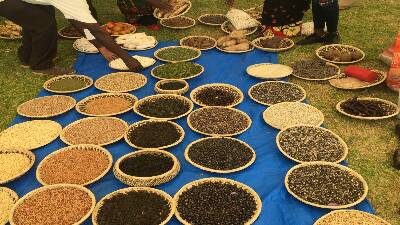One year on Global Biodiversity Framework set to allow more biodiversity loss
The Kunming-Montreal Global Biodiversity Framework was adopted a year ago to stop the rapid decline of biodiversity but serious flaws cast doubt on its ability to deliver.
Ecosystem destruction and the rapid loss of biodiversity are undermining the sustainable production of healthy and culturally appropriate food and thus the realization of the Right to Food and Nutrition (RtFN). According to the United Nations Food and Agriculture Organization (FAO), 75% of plant genetic diversity has been lost since the beginning of the 20th century, as farmers worldwide have abandoned their local seeds for genetically uniform varieties. Today, out of 6,000 plant species cultivated for food, just nine account for 66% of total crop production. In addition, 90% of cattle reared in the global north originate in only six breeds and 20% of livestock breeds are at risk of extinction.
The Kunming-Montreal Global Biodiversity Framework (KMGBF) was adopted by the states parties to the Convention on Biological Diversity (CBD) on 18 December 2022 as a global plan to protect biodiversity. However, a new policy paper Selling Nature or Protecting Rights? A Right to Food Perspective on the Kunming-Montreal Global Biodiversity Framework shows that its underlying premises give rise to concern that it enables business as usual, allowing more destruction and violation of communities’ rights.
As our analysis shows, the framework fails to establish a path away from highly destructive industrial agriculture and other extractive activities and towards agroecology. A case in point is the KMGBF’s Target 7, which fails to set a time frame to phase out pesticides, instead calling for a reduction of “overall risk from pesticides and highly hazardous chemicals.”
Embracing the monetization of 'nature'
It is particularly concerning that the KMGBF embraces so-called nature-based solutions (NBS), which have become the current buzzword among many governments, conservation groups, as well as “green” and ”blue” business and financial circles. The concept has a nice ring to it, but it is dangerously ill-defined and usually takes the form of offsetting schemes, which tie the protection of biodiversity in one place to its ongoing destruction elsewhere. As such, NBS are becoming part of the problem, encouraging more land, forest and ocean grabs in areas owned and managed by Indigenous Peoples, small-scale food producers, and other communities.
Moreover, the KMGBF is an open door for profit-oriented interest group to set the priorities for biodiversity action as it allows private, blended and “innovative” finance, without any social and environmental safeguards. Since its adoption, some governments have pushed for the creation of biodiversity credit markets. In addition, countries such as Barbados, Belize, Ecuador and Gabon have agreed to so-called Debt-for-Nature swaps to refinance their debt in return for conservation commitments. Developing countries’ largely illegitimate debt is thus used as a lever for neo-colonial financial exploitation in the name of biodiversity protection.
Protect biodiversity custodians’ rights
The KMGBF adopts a human rights-based approach to biodiversity and contains important provisions regarding the rights of Indigenous Peoples and local communities as well as gender and intergenerational justice. However, the so-called 30x30 Target, according to which 30% of the world’s land and water surface needs to be under conservation regimes by 2030, revives a “fortress conservation” approach, which has led to systematic violations of local communities’ rights.
The conservation and sustainable use of biodiversity is only possible by respecting and protecting the rights of those people and communities who act as the stewards of much of biodiversity – peasants, Indigenous Peoples, pastoralists, forest people, small-scale fishers etc. Agricultural biodiversity is the result of the interplay of cultural and biological diversity across all ecosystems over thousands of years, based on the knowledge, innovations and practices of communities. Peasants’ and Indigenous Peoples’ distinct systems to conserve, manage, nurture, and further develop their seeds and breeds within their territories and agricultural ecosystems hold the key for biodiversity protection.
Despite its significant shortcomings, the KMGBF and the increased attention to biodiversity that it has generated should be used in a tactical and pragmatic manner to advance agroecology and the rights of Indigenous Peoples, peasants and other rural people.
For more information or media interviews please contact Clara Roig Medina roig@fian.org or Tom Sullivan sullivan@fian.org



